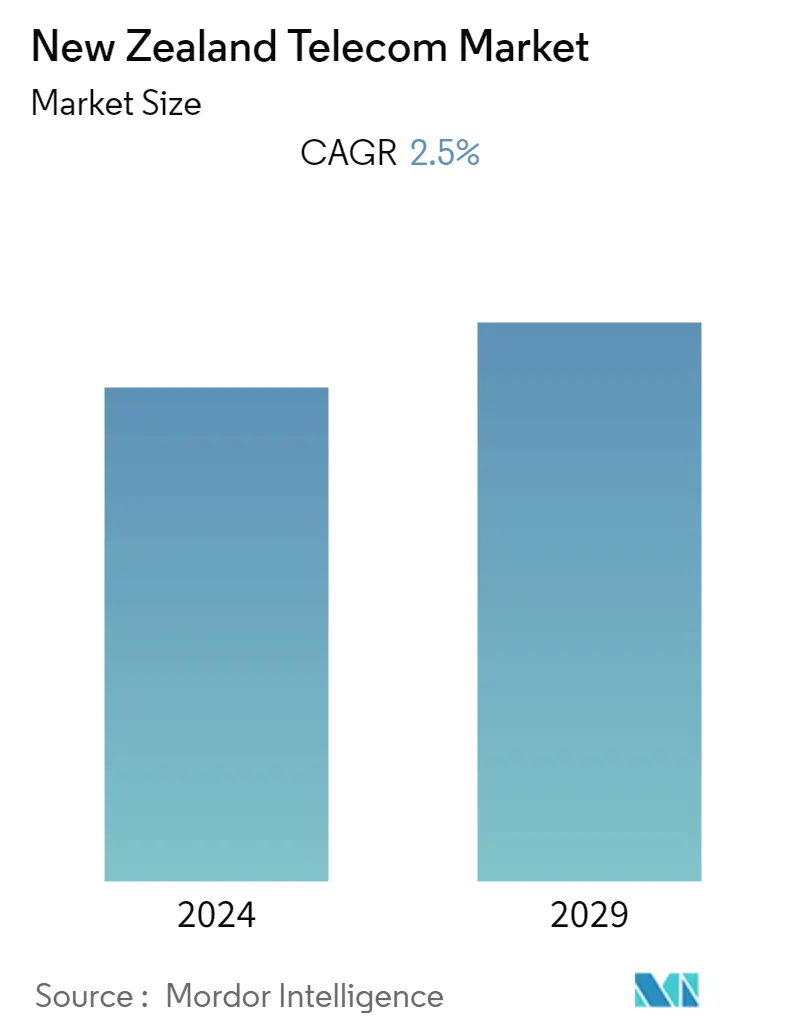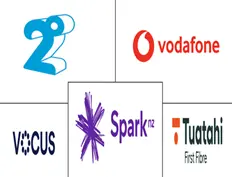Market Size of New Zealand Telecom Industry

| Study Period | 2019 - 2029 |
| Base Year For Estimation | 2023 |
| Forecast Data Period | 2024 - 2029 |
| Historical Data Period | 2019 - 2022 |
| CAGR | 2.50 % |
| Market Concentration | Low |
Major Players
*Disclaimer: Major Players sorted in no particular order |
New Zealand Telecom Market Analysis
The telecom market in New Zealand is expected to witness a CAGR of 2.5% over the next five years. This growth is attributable to the huge acceptance of UFB fiber internet and the popularity of mobile plans with unlimited data. Although there are three major telecom players in the country, namely, Spark New Zealand Limited, Two Degrees Mobile Limited, and Vodafone New Zealand Limited, several small broadband vendors are expanding their market shares.
- One of the highest rates of investment in the OECD is being made in the telecommunications sector in New Zealand. The telecom sector offers a variety of services that are becoming more and more competitive in terms of both price and quality when compared to other nations, making it one of New Zealand's most inventive industries. The industry is witnessing technical advancements, boosting the economy's fundamental production potential and raising the country's overall standard of living.
- The Commerce Commission's Annual Telecommunication Monitoring Report confirmed that the telecommunications industry is positively responding to New Zealanders' demand for access to high-quality and top-notch telecommunications services. The sector can fulfill the customer demand for more data, as mobile data consumption is up by 35% and broadband data consumption is up by 21% compared to 2018 levels.
- Digital technology is already playing a big part in the country's infrastructure solutions. Spark, along with the key telecom players in the country, is actively exploring digital transformation to improve its business agility and spur development. This entails utilizing digital technology to enhance the client experience through enhanced wireless options, increased efficiency in service delivery, and streamlined and automated processes. The company's strategy outlines how New Zealand can take advantage of possibilities presented by digital technology, such as how digital infrastructure can alleviate the country's infrastructure deficit while simultaneously promoting environmental outcomes.
- The New Zealand government is collaborating with the country's three largest network providers (Spark, Vodafone, and 2Degrees-and shared network infrastructure provider Dense Air) to enhance rural connectivity and speed up the rollout of 5G services in smaller towns. The board has decided to grant long-term access to the 3.5 GHz frequency band through a direct allocation process as part of the government's commitment to enhance rural connectivity. To start the 5G rollout in Aotearoa, New Zealand, the government granted short-term early access to this spectrum in 2020.
- COVID-19 was a turning point for digital internet access in New Zealand. Before the pandemic, the telecommunications industry had gone through a decade in which demand for fixed and mobile services rose relatively steadily. While demand growth frequently outpaced initial projections during the pandemic, the sector made sure that investment kept up with the growing needs of consumers and businesses. The scope and pattern of usage of telecommunications services, however, have undergone enormous and unprecedented changes during the pandemic. The fixed and mobile networks demonstrated world-class capacity, speed, and reach.
New Zealand Telecom Industry Segmentation
Telecom or Telecommunication is the long-range transmission of information by electromagnetic means. The New Zealand Market includes an in-depth trend analysis based on connectivity like fixed networks, mobile networks, and telecom towers.
The New Zealand telecom market is segmented by services, which have been further classified into voice services (wired, wireless), data and messaging services, and OTT and pay TV. The market sizes and forecasts are provided in terms of value (USD million) for all the above segments.
| Segmentation by Services (Coverage to Include Average Revenue Per User for the Overall Services Segment, Market Size and Estimates for Each Segment, and In-depth Trend Analysis) | ||||
| ||||
| Data and Messaging Services (Coverage to Include Internet and Handset Data Packages and Package Discounts) | ||||
| OTT and Pay-TV Services |
New Zealand Telecom Market Size Summary
The New Zealand telecom market is poised for steady growth, driven by the widespread adoption of ultra-fast broadband (UFB) fiber internet and the increasing popularity of mobile plans offering unlimited data. Despite the presence of three dominant players—Spark New Zealand Limited, Two Degrees Mobile Limited, and Vodafone New Zealand Limited—the market is also seeing a rise in smaller broadband vendors expanding their reach. The sector is characterized by significant investment, making it one of the most innovative industries in the country. This competitive landscape is further enhanced by technological advancements that are boosting the economy's production potential and improving the standard of living. The government's collaboration with major network providers to enhance rural connectivity and expedite 5G rollout underscores the commitment to improving telecommunications infrastructure across the nation.
The impact of COVID-19 has been transformative, accelerating the demand for digital internet access and prompting substantial investments to meet the evolving needs of consumers and businesses. The rollout of UFB fiber and 4G wireless broadband has significantly improved high-speed broadband performance and accessibility, enhancing the effectiveness of video streaming services. As 5G networks become more prevalent, there is an anticipated increase in smartphone usage for video streaming and gaming, reflecting the growing interest in subscription video-on-demand services. The government's Rural Capacity Upgrade project aims to extend high-speed internet access to rural areas, supported by substantial funding and collaboration with private sector contractors. This initiative, along with other digital infrastructure projects, highlights New Zealand's proactive approach to digitalization and its commitment to bridging the connectivity gap across the country.
New Zealand Telecom Market Size - Table of Contents
-
1. MARKET INSIGHTS
-
1.1 Market Overview
-
1.2 Industry Ecosystem Analysis
-
1.3 Industry Attractiveness - Porter's Five Force Analysis
-
1.3.1 Bargaining Power of Suppliers
-
1.3.2 Bargaining Power of Consumers
-
1.3.3 Threat of New Entrants
-
1.3.4 Threat of Substitute Products
-
1.3.5 Intensity of Competitive Rivalry
-
-
1.4 COVID-19 Impact on the Industry Ecosystem
-
1.5 Regulatory Landscape in the Country
-
-
2. MARKET SEGMENTATION
-
2.1 Segmentation by Services (Coverage to Include Average Revenue Per User for the Overall Services Segment, Market Size and Estimates for Each Segment, and In-depth Trend Analysis)
-
2.1.1 Voice Services
-
2.1.1.1 Wired
-
2.1.1.2 Wireless
-
-
2.1.2 Data and Messaging Services (Coverage to Include Internet and Handset Data Packages and Package Discounts)
-
2.1.3 OTT and Pay-TV Services
-
-
New Zealand Telecom Market Size FAQs
What is the current New Zealand Telecom Market size?
The New Zealand Telecom Market is projected to register a CAGR of 2.5% during the forecast period (2024-2029)
Who are the key players in New Zealand Telecom Market?
Spark New Zealand Limited , Two Degrees Mobile Limited , Vodafone New Zealand Limited , Vocus Group Limited and Tuatahi First Fibre are the major companies operating in the New Zealand Telecom Market.

